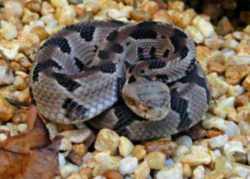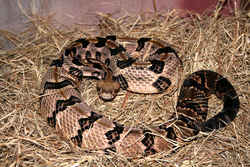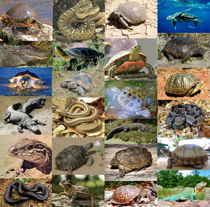
West Virginia Symbols
West Virginia State Reptile
West Virginia Timber rattlesnake
(Crotalus horridus)
Adopted in 2008.
In 2008 the West Virginia Legislature designated the timber rattlesnake as the State Reptile. It is listed as a species of concern on the Monongahela National Forest. The timber rattlesnake is the only rattlesnake species inhabiting West Virginia. Found through out West Virginia, (Crotalus horridus,) often grows to a length of about 3 feet with the occasional specimen reaching a little more than 5 feet and weighing up to 5 pounds. The idea to designate the timber rattler as the state reptile was proposed by a class at Romney Middle School in Hampshire County.
West Virginia State
Reptile:
West Virginia Timber rattlesnake

Measuring from 3-4.5 feet (91-137 cm) or more in length, the timber rattlesnake is the largest venomous snake in New York. The record length is 741/2 inches (189 cm). Timber rattlers impress one as being very stocky; they are large snakes. Despite their size, cryptic coloration allows them to be easily concealed. Two color patterns are commonly found: a yellow phase, which has black or dark brown crossbands on a lighter background color of yellow, brown or gray, and a black phase, which has dark crossbands on a dark background. Black or dark brown stippling also occurs to varying degrees, to the extent that some individuals appear all black. Scales are ridged, giving this rattlesnake a rough-skinned appearance. The timber rattler has a broadly triangular head with many small scales on the crown of the head bordered by a few large scales, unlike the massasauga rattlesnake which has nine large scales on the top of the head.
Like other members of the pit-viper family, the timber rattlesnake has a temperature- sensitive opening, or pit, on either side of the face between and a little below the eye and nostril. This sensory organ is used to detect prey and potential predators. Another feature distinctive of rattlesnakes is the rattle itself. This structure is made of loosely attached horny segments. A new segment is added each time the snake sheds. When vibrated, the rattle makes a buzzing sound characteristic of a disturbed rattlesnake.
Life History
Timber rattlesnakes are active from late April until mid-October, although in northern New York they may not emerge until mid-May. Upon emerging from the den, they are very lethargic. Little feeding occurs early in the spring. Mating occurs in the spring and fall. Males are especially active at this time, seeking out females by following the pheromone (sex attractant odor) they emit. The gestation period is 4-5 months. Females give birth to 4-14 (average 9) young every three to five years during late August to mid-September. The young are approximately 1 foot (30 cm) in length at birth and emerge singly from the female, encased in a transparent membrane which is shed in a few minutes. Each is equipped with venom, hollow fangs and a tiny rattle segment called a "button." Their skin has a velvety texture and the coloring is essentially the same as the adult's. They remain in the area for 1-2 weeks before shedding their skin and dispersing. The young follow the adult's scent trail back to the den. Males are sexually mature in 5 years, females in 7-11 years. Their average life span is 16-22 years, with a maximum age of about 30 years. During winter, dozens of timber rattlers may congregate together in a den to hibernate below the frost line in association with copperheads (Agkistrodon contortrix), other snakes, and skinks (Eumeces spp.). Dens are generally on open, steep, south facing slopes with rock fissures or talus surrounded by hardwood forests.
Adults shed their skin every one or two years, with the average being every 1.4 years. A new rattle segment is added each time shedding occurs. Snakes with a complete set of rattles are rarely seen, however, since the rattles regularly break off. This rattler feeds primarily on small mammals, but occasionally takes small birds, amphibians and other snakes. The venom, which is used primarily to immobilize prey, can be fatal to humans if the bite is untreated. However, in New York there have been no records of human deaths attributable to rattlesnakes in the wild during the last several decades. Contrary to popular opinion, a rattlesnake will not pursue or attack a person unless threatened or provoked.
West Virginia Senate Concurrent Resolution No. 28
(By Senators Barnes, Love, Fanning, White and Sypolt)
Designating the timber rattlesnake as West Virginia's state reptile and designating Megalonyx Jeffersonii as West Virginia's state fossil.
Whereas, The timber rattlesnake is an integral part of the history, culture and ecology of West Virginia and the United States; and
Whereas, The timber rattlesnake is present throughout West Virginia and its color and pattern is reminiscent of West Virginia's fauna and flora; and
Whereas, The timber rattlesnake is important to preserve as a predator and prey in West Virginia's ecology; and
Whereas, The timber rattlesnake kills mice and rats at no cost while cleaning up after itself; and
Whereas, The timber rattlesnake is a popular icon that does attract attention and, thereby, may enhance tourism; and
Whereas, Since no other state has adopted the timber rattlesnake as a state reptile, West Virginia can be the first and it would be a proud contribution
by the eighth grade class at Romney Middle School, from West Virginia's oldest county, in West Virginia's oldest town, to have been instrumental in
making the timber rattlesnake the state reptile of West Virginia; and
Whereas, No fossil has been designated as the official state fossil for the State of West Virginia; and
Whereas, Interest in fossils and paleontology has become increasingly widespread throughout the citizenry of this state, there currently being fossil,
rock and gem clubs already organized in the counties of Cabell, Harrison, Kanawha and Wood; and
Whereas, In 1797, President Thomas Jefferson obtained and described fossil bones from a limestone cave in what is now Monroe County; and
Whereas, These bones were again described by Casper Wistar in 1799 as the bones of a giant extinct ground sloth; and
Whereas, Wistar named the bones as a new species, Megalonyx Jeffersonnii, in honor of President Jefferson; and
Whereas, The bones are from the Ice Age or Pleistocene Epoch which lasted from 10,000 to 1.8 million years ago; and
Whereas, The designation of a state fossil would aid in the promotion of interest in geology, paleontology and history; and
Whereas, The bones afford an opportunity for special studies in American, state and natural history for the students of the state; and
Whereas, Thirty-nine of the 50 states have an official state fossil; therefore, be it
Resolved by the Legislature of West Virginia:
That the Legislature hereby designates the timber rattlesnake as West Virginia's state reptile and designates the fossil Megalonyx Jeffersonnii as
West Virginia's state fossil; and, be it
Further Resolved, That the Clerk of the Senate is hereby directed to forward copies of this resolution to the citizens and schools in the state.
Taxonomic Hierarchy: Timber Rattlesnake
Kingdom: Animalia
Phylum: Chordata
Subphylum: Vertebrata
Class: Reptilia
Order: Squamata
Suborder: Serpentes
Family: Viperidae
Subfamily: Crotalinae
Genus: Crotalus
Species: C. horridus







